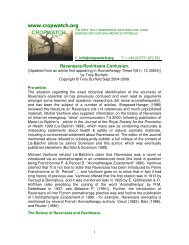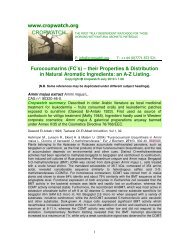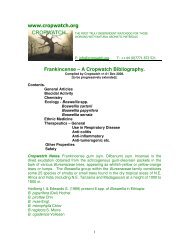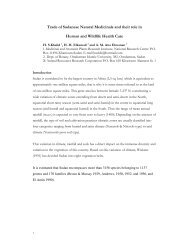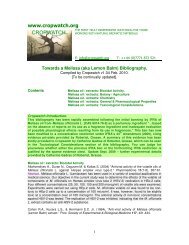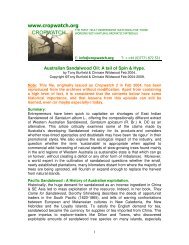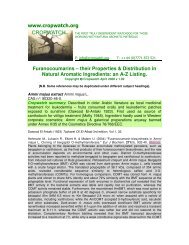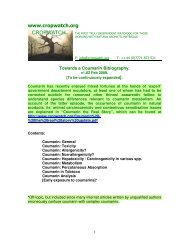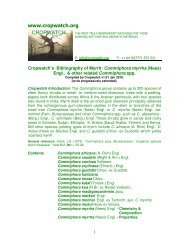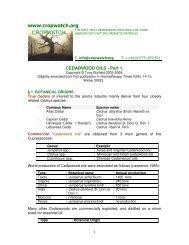Sandalwood Biblio - Cropwatch
Sandalwood Biblio - Cropwatch
Sandalwood Biblio - Cropwatch
You also want an ePaper? Increase the reach of your titles
YUMPU automatically turns print PDFs into web optimized ePapers that Google loves.
Chandrashekharaiah A.M. & Dahgar V.M. (1998) “The effect of sandalwood availability on the<br />
craftsman community.” In: Sandal & its products. ACIAR Proceedings (84) eds. ACIAR<br />
Proceedings (84) eds. A.M. Radomiljac & R.H. Aanathapadmanabha, Welbourn R.M. and<br />
Satyanarayana Rao, Publication – Australian Centre for International Agricultural Research,<br />
Canberra 19-21. (1998).<br />
Chandrashekharaiah A.M. (1971) “Sandal tree”. My Forest 8, 21-25.<br />
Chapuis C. (2004) "In the quest for a virtual pseudo receptor for sandalwood-like odorants. Part I:<br />
The empirical approach." Chem Biodivers.1(7):980-1021. Abstract. Based on similarities between<br />
naturally occurring (-)-(Z)-β-- or (+)-(Z)-α-santalol ((-)- 1 or (+)-2, resp.) and the reversed (E)-<br />
configured synthetic derivatives from campholenal (7a), a simple model A was developed.<br />
Besides reconciliation of this stereochemical aspect, this initial model also tentatively explained<br />
the enantiodiscriminations as well as the large spectra of distances separating the OH function<br />
from the lipophilic quaternary center(s) reported for different classes of substrates. Evolution,<br />
modifications, and refinement of this imperfect model allied with the research for alternative<br />
possibilities are illustrated, along with a historical guideline, in the light of olfactively challenging<br />
synthetic seco-substructures as well as literature reports. Despite evolution of the inadequate<br />
model A and a plausible interpretation of the lipophilic part, the topological positions of the OH<br />
function and its vicinal alkyl substituent could nevertheless not be fully ascertained by this<br />
approach. This apparently inconclusive empirical concept prompted us to turn our attention<br />
towards a computerized methodology, which will constitute the second and third part of this study.<br />
Chawla G. (2008) ““The demise of India’s supply: resorting to substitutes to meet demand.”<br />
<strong>Sandalwood</strong> Conference 2008 at The Kimberley Grande, Kununurra, W. Australia 13-15 May<br />
2008. <strong>Cropwatch</strong> Comments: Chawla illustrates the demise of EI sandalwood’s decline via the<br />
annual production figure for sandalwwod sales in Tamilnadu, which peaked at 2330.5 tons in<br />
1999-2000, against just 14 tons in 2007-8. Also of interest were facts about the selection of 79 or<br />
more sandalwwod trees maintained at the IWST germplasm bank in Gottipura and about the<br />
clonal seed orchards from these trees maintained at Nalla Nallal and Jarakabande and at the<br />
Andhra Pradesh Forest Department Research Center, BIOTRIM, at Tirupathi. .<br />
Christenson P.A., Secord N. & Willis B.J. (1981) Phytochemistry 20(5), 1139-1141. Abstract: An<br />
analysis of East Indian sandalwood oil (Santalum album) has resulted in the isolation and<br />
identification of trans-β-santalol and epi-cis-β- santalol.<br />
Choudhuri J.C.B. (1963) "<strong>Sandalwood</strong> tree & its diseases." Indian Forester 89(7), 456-462.<br />
Choueiri A. (2008) “Sustainable ingredients in the fragrance industry and the use of Indian<br />
<strong>Sandalwood</strong> in L’Oreal products”. <strong>Sandalwood</strong> Conference 2008 at The Kimberley Grande,<br />
Kununurra, W. Australia 13-15 May 2008 <strong>Cropwatch</strong> Comments: Drawing on data from<br />
Edwards M. Fragrances of the World, Choueiri (Head of Lancome UK) includes the point that of<br />
106 current fragrances listing sandalwood, only 36 detail Indian sandalwood, and of those, only<br />
16 detail Mysore sandalwood (the rest we assume use sandalwood from other sources). Of these<br />
sixteen current fragrances allegedly employing Mysore sandalwood, four are supplied by IFF, two<br />
by Givaudin (Quest), one by Firmenich and one by Symrise. The present situation of shortage<br />
seems a far cry from the original launching of three fragrances containing authentic sandalwood<br />
by the antique pharmacy of Santa Maria Novella, Florence in 1828.<br />
Das S., Das S., Pal S., Mujib A., Sahoo S. S., Dey S., Ponde N. R. & Dasgupta S.(1999). “A<br />
novel process for rapidmass propagation of Santalum album L. in liquid media and bioreactors.”<br />
In: Giberti, G. (Ed) Proc. WOCMAP-2. Acta Hort. 502(ISHS), 281-288.<br />
Das S., Ray S., Dey S. & Dasgupta S. (2001). "Optimisation of sucrose, inorganic nitrogen and<br />
abscisic acid levels for Santalum album L. somatic embryoproduc tion in suspension culture.”<br />
Process Biochemistry (details)<br />
44





